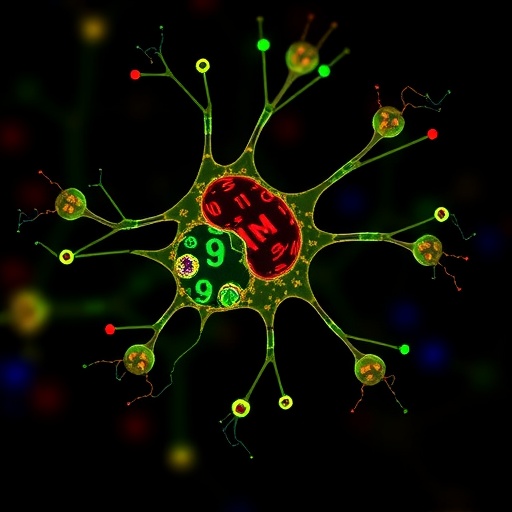In a breakthrough that could revolutionize the management of diabetic bone injuries, scientists have developed a cutting-edge microenvironment-responsive hydrogel that holds remarkable promise for promoting bone regeneration in diabetic patients. This multifunctional enzyme-linked hydrogel, recently reported by Fu et al. in Nature Communications, represents a significant stride in biomaterials science, tailored specifically to tackle the complex pathological conditions inherent in diabetes-impaired bone healing. The innovative approach leverages the dynamic biochemical milieu of diabetic bone defects, offering a smart and adaptive therapeutic platform with far-reaching clinical implications.
Diabetic patients frequently suffer from impaired bone repair due to chronic inflammation, oxidative stress, and insufficient vascularization—a trifecta that severely compromises the body’s natural regenerative ability. Conventional bone repair strategies often fall short when applied in diabetic contexts because they do not adequately address these intertwined pathological barriers. Recognizing this gap, Fu and colleagues engineered a bioresponsive hydrogel system that skillfully integrates enzymatic functionality to modulate the local microenvironment, thereby optimizing conditions for bone tissue regeneration. This advancement is poised to redefine therapeutic paradigms by providing a responsive scaffold that interacts in real-time with the diseased tissue environment.
At the core of this technology lies an intelligently designed hydrogel matrix imbued with enzyme-mimetic properties capable of sensing and responding to the fluctuating oxidative and inflammatory status within diabetic bone lesions. The hydrogel’s structure capitalizes on enzyme-linked components that not only catalyze beneficial biochemical reactions but also degrade in synchrony with the healing process, ensuring a gradual release of therapeutic agents and structural support. This biocompatible and biodegradable framework mimics natural extracellular matrix components, encouraging cellular adhesion, proliferation, and differentiation—a critical sequence for effective bone regeneration.
One of the pivotal challenges addressed by this hydrogel concerns the harsh diabetic microenvironment, characterized by excessive reactive oxygen species (ROS) accumulation and persistent inflammation, which jointly hinder osteogenic activity. By incorporating enzyme-like catalytic domains, the hydrogel actively scavenges ROS, thus mitigating oxidative stress and attenuating inflammation locally. This dual-action mechanism not only protects resident osteoblasts and mesenchymal stem cells but also reactivates their regenerative potential. Such targeted microenvironment modulation marks a transformative shift from passive scaffolds to bioactive therapeutic platforms.
Furthermore, the hydrogel serves as a controlled delivery vehicle, systematically releasing osteoinductive growth factors and ions essential for bone mineralization. The enzymatic linkages within the hydrogel matrix facilitate precise, on-demand release kinetics that respond adaptively to the surrounding biochemical stimuli. This ensures that the regenerative signals are delivered at critical junctures during the healing timeline, enhancing osteogenesis while minimizing potential side effects associated with systemic drug administration. The engineered hydrogel thereby balances structural integrity with dynamic biochemical interaction, optimizing the spatiotemporal presentation of regenerative cues.
The research includes comprehensive in vitro and in vivo experiments illustrating the hydrogel’s efficacy. Cellular studies underscore enhanced proliferation and differentiation of osteoprogenitor cells within the hydrogel microenvironment, while animal diabetic models exhibit accelerated bone defect closure contrasted with controls. Histological analyses demonstrate denser collagen matrix deposition, increased vascularization, and a mature lamellar bone structure restored in treated defects. These biological validations attest to the hydrogel’s intrinsic ability to overcome the impaired healing cascade characteristic of diabetic bone injuries.
Importantly, the design addresses biocompatibility and safety concerns through the use of naturally derived polymers and meticulously engineered enzymatic components. Biodegradation rates harmonize with tissue regeneration pace, preventing fibrotic encapsulation or chronic foreign body reactions. The multifunctional hydrogel also maintains mechanical properties conducive to bearing physiological loads, circumventing the fragility issues that have plagued previous biomaterial scaffolds deployed in orthopedic applications. The balance between robustness and biodegradability is a cornerstone of its translational potential.
This enzyme-linked hydrogel platform also holds promise beyond diabetic contexts, with applicability to other challenging chronic wounds and degenerative orthopedic conditions where oxidative stress and inflammation impede tissue repair. By embedding microenvironmental responsiveness into biomaterials, the study pioneers a versatile strategy that can be customized using different enzymatic or signaling modules to suit diverse pathological states. This opens avenues for next-generation regenerative therapies that transcend one-size-fits-all approaches and usher in personalized medicine tailored to individual tissue milieus.
Clinicians treating diabetic bone defects are poised to benefit immensely from this technology, which could shorten recovery times, reduce the incidence of non-union or infection, and improve overall patient outcomes. The hydrogel’s capability to coax native cells into reparative phenotypes without necessitating exogenous stem cell transplantation further enhances its clinical appeal, lowering treatment complexity and cost. Additionally, the injectable and minimally invasive nature of the hydrogel facilitates outpatient management of bone injuries, a marked advantage over conventional grafting or surgical interventions.
Looking forward, the intersection of materials science, enzymology, and regenerative medicine exemplified by this microenvironment-responsive hydrogel suggests a fertile frontier for innovation. The research by Fu et al. catalyzes exciting prospects for integrating biomaterials with molecular sensors and active therapeutic agents that seamlessly interact with host physiology. Such synergistic approaches promise not only improved healing of diabetic bone defects but also the broader regeneration of complex tissues impaired by chronic disease states.
In sum, this pioneering work lays down a blueprint for harnessing endogenous biochemical pathways through smart biomaterial design, enabling targeted, adaptive, and efficient regeneration within hostile microenvironments. It marks a significant departure from conventional tissue engineering toward a future where biomaterials intelligently orchestrate cellular and molecular events for optimal healing. As this hydrogel advances toward clinical validation and real-world application, it stands to transform outcomes for millions suffering from bone defects exacerbated by diabetes, a global health burden of escalating prevalence.
The evolution of enzyme-linked hydrogels further heralds a new era where regenerative scaffolds are equipped with autonomous feedback mechanisms akin to living tissues. By closing the loop between biomaterial function and dynamic microenvironmental cues, such systems could revolutionize treatment regimes across orthopedic, cardiovascular, and neurodegenerative disorders. The potential to engineer multifunctional platforms that self-regulate to maintain homeostasis and stimulate repair aligns with emerging trends in precision medicine, paving the way for breakthroughs in chronic disease management.
Moreover, this study’s integration of catalytic enzymes within a hydrogel matrix demonstrates the feasibility of embedding active biomolecules in synthetic scaffolds without compromising structural and mechanical integrity. This strategy contrasts traditional drug-eluting or passive scaffolds, showcasing how biomaterials can evolve toward multi-tasking devices that sense, respond, and modulate pathophysiology in situ. By expanding the toolkit of bioresponsive elements, researchers can tailor regeneration therapies with unparalleled specificity and efficacy.
Ultimately, the microenvironment-responsive multifunctional enzyme-linked hydrogel developed by Fu and colleagues encapsulates the future of biomaterials-based regenerative medicine: smart, adaptive, and inherently aligned with the body’s healing processes. Its success underscores the necessity of interdisciplinary collaboration, uniting insights from biochemistry, materials science, and clinical medicine to confront complex challenges posed by diabetic bone repair. As translational and manufacturing hurdles are addressed, this innovation paves the way toward new standards in personalized tissue regeneration and improved quality of life for patients worldwide.
Subject of Research:
Diabetic bone defect regeneration using microenvironment-responsive enzyme-linked hydrogels.
Article Title:
Microenvironment-responsive multifunctional enzyme-linked hydrogel for diabetic bone defect regeneration.
Article References:
Fu, X., Luo, Z., Guo, Y. et al. Microenvironment-responsive multifunctional enzyme-linked hydrogel for diabetic bone defect regeneration. Nat Commun 16, 10275 (2025). https://doi.org/10.1038/s41467-025-65165-5
Image Credits: AI Generated
DOI: https://doi.org/10.1038/s41467-025-65165-5
Tags: bioresponsive biomaterialsbone healing in diabeteschronic inflammation in diabetesdiabetic bone regenerationdynamic biochemical microenvironmentenzyme-linked hydrogel applicationsinnovative bone repair strategiesmultifunctional hydrogel technologyoxidative stress and bone repairsmart enzyme hydrogeltherapeutic platforms for bone defectsvascularization in diabetic patients





